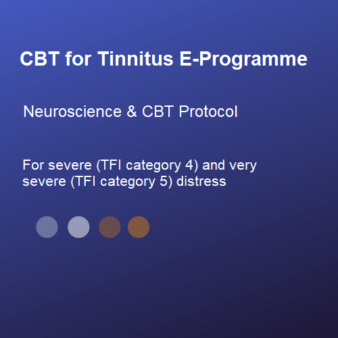To all new TEP registrants on Module 1
Published by Debbie Featherstone in Archive · Wednesday 02 Aug 2017
This post has been updated to include changes incorporated in to the Tinnitus E-Programme since the original blog post in 2017
You have recently registered to use the Tinnitus E-Programme – a big welcome! I hope you are finding your way around the website www.tinnituseprogram.org
Just a few pointers for you during your first week:
Measures
If you haven’t done so, please make sure you complete and send in your THI (Tinnitus Handicap Inventory). Some of you have done so already, so thank you!
There are 2 more measures that you are asked to complete – the TFI (Tinnitus Functional Index) and the BAI (Beck Anxiety Inventory).
In my own clinical practice, the TFI appears to be more sensitive to change in each of the domains measured than the THI can offer, and has recently completed UK Validation by NIHR NHBRC. On reading the research paper, however, NHBRC conclude the following:
“Conclusion: Even though the proposed 8-factor structure was not fully confirmed for this population, the TFI appears to cover multiple symptom domains, and to measure the construct of tinnitus with an excellent reliability in distinguishing between patients. While the TFI may discriminate those whose tinnitus is not a problem, floor effects in many items means it is less appropriate as a measure of change in this subgroup. Further investigation is needed to determine whether these effects are relevant in other populations.”
If you are interested to read the whole paper, you can download it from the Other resources area of the TEP website.
The second of the 2 additional measures is the Beck Anxiety Inventory (BAI). As with the THI and TFI, I use this in my clinics all the time and have done for many years now. It measures 21 symptoms of anxiety. The BAI does not directly reflect your tinnitus of course; however, anxiety does affect tinnitus distress as you will already know.
So, I would ask you to spend a few minutes completing the online TFI and BAI (as well as the THI) and send them in.
The whole point of using measures such as these is to be able to measure your progress and measure how much your learning and practical exercises benefit you. By completing them at the start, you have something to measure against at the end of the course.
In addition to the above information by email, I have added a small section this morning about measures on the Tinnitus E-Programme blog
Breathing Exercise
I cannot stress to you enough how important it is that you begin to use the breathing exercise a minimum 3 times each day.
Build it in to your daily routine until it becomes part of what you do naturally. Before we can even begin to expect to reduce high arousal levels by changing what we think and the way we think, we need to work on the physiology that is creating stress and tension. We do that by engaging parasympathetic activity (relaxation/calm) through the breathing exercise, which then allows a reduction in levels of arousal/stress (sympathetic activity) in the Autonomic Nervous System.
The neocortex (the part of the brain we need to be functioning well in order to be able to think logically and rationally) is completely overwhelmed by high arousal levels and really struggles to function. By increasing parasympathetic activity (through using ‘intentional focused’ breathing), we reduce sympathetic activity (arousal/stress). The more ‘balanced’ the autonomic nervous system becomes, the more we free up the neocortex to function effectively.
By regularly using the breathing exercise, there is a link that builds between the mind and the body. The brain teaches the body it can feel less tense, and the body feeds back the calm to the brain.
From module 2, we continue using the breathing exercise and add to it by using a 30 minute guided relaxation recording each day. This is all in preparation for session 4, when your neocortex should be ready to begin challenging those “Negative Automatic Thoughts” (negative self-talk) that have been driving high arousal levels.
Work session by session – week by week
Please do NOT race ahead with the sessions. The course will only work for you if you give yourself time to practice the breathing and relaxation week by week, and allow what you are learning each week (the reading materials) to ‘sink in’.
I can appreciate you want the TEP to work for you – so do I. But neither the mind nor the body will be rushed! Give yourself this opportunity to improve your lot! Rushing through the course materials won’t do that.
At the end of each session, you will see there is a short Progress Check. Some of you have sent in both session 1 and 2 progress checks. Can I ask that you just keep to doing the one a week. Keep to the pace intended – as I say, it cannot be rushed. There really does need to be a week between each session.
Lastly, I’m sorry this first email is so lengthy! I just want to make sure you get off to the best possible start.
I will be putting the contents of this email in to the Comments on Session One area of the blog at some point. So you will be able to find what’s detailed in this email in the Tinnitus E-Programme blog.
Enjoy the rest of your week – and the rest of the course!
Debbie Featherstone
Tinnitus E-Programme
Post sources:
- Tinnitus E-=Programme: http://www.tinnituseprogram.org
0
reviews



